
Preeminent Italian design and quality brought to you by Copenhagen. Come experience our carefully curated collection.

Enhance your dining experience with the sculptural elegance of the Butterfly dining table by Cattelan of Italy. A ribbon of solid steel is artistically finished in brushed grey and supports a top of extra clear glass for a truly sophisticated look. This table is available from stock for quick delivery in either 94.5” or 118” lengths, both in a generous 48” width. Shown with the beautiful all-leather Zuleika dining chair. Call the location nearest you for pricing.

phoenix tucson
gilber t
el paso
scottsdale
austin san antonio

Austin 2236 West Braker Lane 512.451.1233 San Antonio 18603 Blanco Road 210.545.4366 furniture & accessories for your modern lifestyle since


" W i t h a p a s s i o n f o r t r a n s f o r m i n g s p a c e s t h r o u g h c o n s c i o u s d e s i g n p r a c t i c e s , w e a p p r o a c h e a c h p r o j e c t m i n d f u l o f h o w i m p a c t f u l e v e r y d e t a i l o f t h e p h y s i c a l e n v i r o n m e n t c a n b e "




4 | AUSTIN WOMAN | FEBRUARY 2023
Rebekka Glass Founder & Interior Designer
Commercial & Residential interior design
I n t e r i o r a r c h i t e c t u r e C u s t o m M i l l w o r k L i g h t i n g D e s i g n S u s t a i n a b l e P r a c t i c e s F u r n i t u r e & S t y l i n g s p a c e p l a n n i n g
BY KATHRYN FREEMAN PHOTOS BY ROMINA OLSON
 BY CY WHITE
BY CY WHITE

32 FEATURE TRAILBLAZER WITH HER MOTHER’S HEART
40 FEATURE HEAVY WORK
ATXWOMAN.COM | 5




6 | AUSTIN WOMAN | FEBRUARY 2023 February CONTENTS 16 STAFF PICKS Who is a Black woman who inspires your equity work? 18 FROM THE DESK OF Erika Nicole 20 SEE HER WORK Swathi Konduri 24 SEE HER WORK Tumi Adeleye 28 ON THE MONEY Closing the Wage Gap 46 BROWN GIRL IN RECOVERY 47 ARTS IN REVIEW 48 I AM AUSTIN WOMAN Ericka Tate 18 20 24 46
Why Italian Furniture’s Originality Withstands the Test of Time

Our homes are a reflection of our lives and ourselves. A place to express our individuality, to relax, recharge, entertain and dream. It makes sense, then, that our interiors serve to help us live more comfortably and beautifully. Perhaps no other furnishings are more uniquely suited for this than the Italian furniture collections available at Copenhagen.
Lars Hansen, Copenhagen’s product director, gives insights and recommendations for those considering high-quality Italian furniture.

“Italians have always been known for beautiful, cutting-edge design, whether it is clothing, textiles or furnishings. People immediately notice something special in the quality and how finishes and colors are put together,” Hansen states. “If you are a fan of contemporary, it doesn’t get better than Italian designed and made.”
Copenhagen’s buying team is always on the lookout for something that catches the eye. “We ask ourselves: Are the shapes unique and pleasing? Are the materials high-quality? Are the colors and finishes put together in a way that is beautiful, unexpected or both?” Hansen says. Often, Italian items fit the bill.
For instance, Cattelan Italia’s Atlantis Dining Table features a Crystalart tabletop that boasts a stunning marbled pattern. Consisting of an artistic print applied to the underside of extra-clear glass, Crystalart is an innovative material that gives you all the beauty of natural stone without the maintenance.
With Alberta’s Freedom Sectional, you and your guests can lounge in style on contemporary angled seats with movable back cushions. Hansen says, “This sectional offers so many configurations, colors and textures that you can truly make it your own. When you walk into your home and see the Freedom sectional, you know you’ve created something unique for your space.”
If you’re
Inspired
The Phantom of the Opera, these mirrors feature surfaces with surreal curves that will imbue your space with a dramatic, otherworldly feel.

Not only is Italian furniture aesthetically stunning, but it’s also meticulously crafted with the highest-quality materials to function smoothly year after year. What’s more, Italian design often mixes textures, colors and materials in a balanced and harmonious way.
Consider Cattelan’s Gordon Deep Wood Table, featuring a rebar base and three-inch-thick top that will stand up to years of family gatherings and special occasions. Hansen says, “Gordon combines two of my favorite elements: industrial steel and natural organic wood incorporating honeycomb, which creates a top that is substantial without being heavy. There is nothing else quite like it.”
Equally impressive is the Lavander Sideboard, sporting three doors carved in a pattern that evokes lavender blossoms. With a textured exterior that catches gradations of light and shadow, and a roomy interior with glass shelving and a silverware drawer, Lavander seamlessly blends elegance and functionality.
Finally, Italian furniture is renowned for its luxurious comfort and that “it” factor that transforms a house into a home. For instance, Incanto’s Lena sleeper sofa creates a cozy and welcoming vibe for you and all your guests, with its textured fabric, layered armrests and ability to turn into a full-size bed.
Similarly, the Sweet Jane Easy Chair by Alberta sports a wide, comfortable seat and curved arms that appear to hug the sitter. “The Sweet Jane,” says Hansen, “aside from its very cool name, combines unexpected design elements to make a chair that just makes you smile when you see it.”
A veteran Copenhagen employee of almost 30 years, Hansen compares his job as a buyer to being “a kid in a candy store.” “I get to see all the new designs first and offer suggestions to manufacturers. I always get excited about a new collection.”
Standout design, quality craftsmanship, comfort—these are just some of the traits that set Italian furniture apart from the crowd. Discover the possibilities of Italian furniture on your next visit to Copenhagen. Offering friendly assistance and expertise, Copenhagen’s team of sales associates and designers are ready to help you create the spaces you’ve always dreamed of, with everything from special order options to expert interior design services. As Hansen succinctly puts it, “You don’t persuade people to buy beautiful furniture. Great design speaks for itself.”
seeking an equally spectacular accent, try the Christine or Phantom Mirrors from FIAM Italia.
by
m Sponsored Content
furniture & accessories for your modern lifestyle
www.copenhagenliving.co
Sweet Jane Easy Chair
Gordon Deep Wood Table
Lavander Sideboard




SCRE E X A M T O D A 2 5 4 - 2 7 7 - 1 2 3 0 Scan to book or call w w w . P i n n a c l e R e s e a r c h . c o m LIVER Fast and Easy, Non-Invasive Procedure. Same-Day Results & Consultation. S C H E D U L E Y O U R F R E E 8 0 1 5 S H O A L C R E E K B L V D . S U I T E 1 1 4 A u s t i n , T X 7 8 7 5 7 M a r k e t i n g @ P i n n a c l e R e s e a r c h . c o m Fatty Liver Disease is the leading cause of liver transplant among women. Early detection is key, get screened 3 2 0 1 S A U S T I N A V E . S U I T E 3 3 5 G e o r g e t o w n , T X 7 8 6 2 6 We’ll tackle your spring cleaning checklist. - Carolyn Haney, Founder haneyhomeconcierge.com 512-608-8872 carolyn@haneyhomeconcierge.com
A PUBLICATION OF AW MEDIA INC.
VOLUME 21, ISSUE 6
SHURONDA ROBINSON CEO KIP GARVEY COO
JEN RAMOS PERKINS Director of Business Operations
JAIME
ALBERS
Creative Director
CY WHITE Managing Editor
DARBY
KENDALL Copy Editor
KRISNA
MENIER
Community and Events Manager
NINA
GLORIA
Production Coordinator
CLAIRE HELENIAK Social Media Specialist

MICHELLE BERMEA Media Sales Executive

CONTRIBUTORS
Editorial: Brown Girl in Recovery, Kathryn Freeman, Samantha Greyson, Jenny Hoff, Ericka Tate, Cy White

Art:
Tumi Adeleye, Brown Girl in Recovery, Jennifer Lindberg Studio, Swathi Konduri, Erika Nicole, Romina Olson
INTERNS
Samantha Greyson, Brena Ullrich
AW MEDIA INC.
MELINDA GARVEY
Co-owner/Co-founder
SHURONDA ROBINSON CEO/Co-owner

LANA MACRUM Co-owner
LYNELLE MCKAY Co-owner
TERRY MITCHELL Co-owner
GRETEL PERERA Co-owner
ANA RUELAS Co-owner
NEHA SAMPAT Co-owner
SAMANTHA STEVENS Co-founder
Contributors
SAMANTHA GREYSON
Writer “Nostalgia Through Color,” Page 20
• She cannot stop crocheting scarves.
• She loves to write and read poetry.
• She is a dedicated plant mom.
“Your individuality is inherent, and as cheesy as it sounds, you are special, because you are uniquely, one-of-a-kind you.”
CY WHITE
Writer, “Heavy Work,” Page 40
• She studies horror films.
• She makes a list of her 100 favorite albums every year.
• Stevie Wonder once said she could sing. (Still dying about that!)
“Trust yourself, even when it’s hard.”
JAIME ALBERS
Creative Director
• She is the biggest Chiefs fan. Go Chiefs!
• In another life, she would have been a chef.
• She is just a simple Midwest girl raising a preteen, a drama queen and two Shi Tzus. “Looking back on my almost 40 years, I wish I could tell my younger self that time heals all wounds. Life is messy and hard, and you will survive and live a beautiful life.”
ROMINA OLSON
Photographer, “Trailblazer with Her Mother’s Heart,” Page 32
• She shares the same Birthday as Leonardo DiCaprio, on 11/11.
• She loves cloud watching with her sons.
Austin Woman is a free monthly publication of AW Media Inc. and is available at locations throughout Austin and in Lakeway, Cedar Park, Round Rock and Pflugerville. All rights reserved.

To offer feedback, email feedback@awmediainc.com. For submission information, visit atxwoman.com/jobs.
No part of the magazine may be reprinted or duplicated without permission. Visit us online at atxwoman.com. Email us at info@awmediainc.com. 512 328.2421 | 7401 West Slaughter Lane, Austin, TX 78739
• She makes a mean pumpkin cheesecake pie. “Make loving yourself a priority and drink lots more water!”
ATXWOMAN.COM | 9
This month, we asked our contributors: What words of love would you tell your younger self?





We are proud to present the eighth annual Woman's Way Business Awards. Categories spread across a wide variety of industries for women who are makers, shakers and disruptors. HEALTH & WELLNESS BEVERAGE & CULINARY ARTS PROFESSIONAL SERVICES MAKER STEM RISING STAR SOCIAL IMPACT BUSINESS TO WATCH $1-5 MILLION BUSINESS TO WATCH > $5 MILLION I AM AUSTIN WOMAN SEE IT TO BE IT

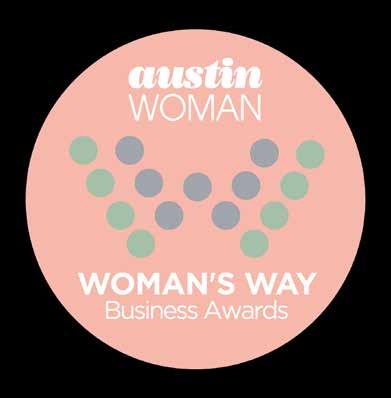







just finished my first month as the CEO of Austin Woman magazine.

Ida B. Wells, a famous journalist, wrote, “The people must know before they can act, and there is no educator to compare with the press.”
I believe in this purpose wholeheartedly—to educate people to take action to better their lives and community. We at Austin Woman can educate, share knowledge and reach women in our community that will transform Austin in an authentic and inspired way.
As I reflect on my new role against the backdrop of Black History Month, I am in awe.
My mother picked cotton in Mississippi as a child to afford fabric for dresses she would have liked to have herself. At school, my father experienced violence from his white peers in Ohio. (His parents moved from Mississippi as part of the Great Migration of Black people out of the South.) He dropped out of high school and was soon drafted to fight in Vietnam.
My mother could not go to the library in her town to read the books there. After returning from Vietnam, my father studied to receive his GED.
How in the world did I get here?
Despite their circumstances, my family upheld a commitment to continuous learning and improvement. The exposure my parents gave me, my brothers and my sister growing up was built on a “no excuses” mindset and a responsibility to help others. My parents’ entrepreneurial spirit was equal to their community impact, and they instilled and cultivated that same spirit in me.
My family used business as a way to elevate the community in some of the same ways I aspire to at Austin Woman magazine.
They started their weekly community newspaper in 1985. I worked there as a child but saw the work as a burden because it “kept me from my friends and doing kid things.” Today, as I look at the foundation they gave me, which has prepared me to take on this new role, I am compelled to say in writing, “Thank you, and I am forever grateful.”
Booker T. Washington, who once came to speak in Austin at Wooldridge Park, said, “If you want to lift yourself up, lift up someone else.” I am committed to strengthening the ecosystem for women in Austin so that we can all thrive.
I welcome this opportunity to lift myself and lift others.
SHURONDA ROBINSON CEO/CO-OWNER

Publication of Austin Woman would not be possible without the support of our monthly advertisers and sponsors, who believe in the impact we are making in the Austin community. The following businesses have stepped up their support of our efforts beyond traditional advertising and we are proud to recognize them as our partners. The team at Austin Woman is grateful for these businesses that have shown their commitment to the advancement of women in Austin and hopes you, as readers, recognize their efforts and support these businesses and all our regular advertisers.

12 | AUSTIN WOMAN | FEBRUARY 2023
DIAMOND-LEVEL PARTNER PLATINUM-LEVEL PARTNERS CEO LETTER
As a CEO and founder, what advice can you give young women who want to bring their vision to fruition?
One piece of advice I would pass on is to force yourself out of your comfort zone. We need to show up and take risks. Ask questions and strive to be involved in the right conversations and projects you’re passionate about. Seek out people with different perspectives. When you step out of your comfort zone, you’ll never stop learning. Then bet on yourself. I was a female entrepreneur in a male-dominated tech industry, spearheaded a company of engineers without an engineering background and ran a company for 12 years without traditional funding. Acknowledge your road may be the road less traveled and lean into those differences. Focus on what you bring to the table that others don’t.
You’ve gone through the struggle to get investment. How do you stay positive in a situation where you’re unsure if you’ll be able to keep afloat?
Cultivating resilience will be your secret sauce. A couple of years after I moved to Silicon Valley to start a tech PR firm, I found myself in a recession with no clients and sleeping in my office after the market crashed. It took a lot of resilience not to give up on my entrepreneurial journey back then, but I pulled myself up and learned how to celebrate the wins and the lows. Every “no” is a lesson. Learn to embrace rejection as an opportunity to learn and grow. Get comfortable with your idea being rejected over and over in your journey— especially since a woman’s ideas are 62% less likely to be endorsed in a work environment. Rejection happens every day—an employee leaves, an investor declines, a potential client goes in another direction. It can be draining. Celebrate the wins so each one feels twice as good as every loss feels bad, and focus on what you learn from the rejection. Big wins don’t come easy. But remind yourself that “If it was easy, anybody could do it. But you’re not just anybody.” I remind myself of this on a daily basis.
What excites you about 2023?
The last few years have been a whirlwind with the economic, political and pandemic-related challenges we’ve been up against. The market correction we are enduring provides some renewed clarity, which I welcome with open arms. We are all challenged with supporting a new balance. As a CEO, this translates to a continued focus and prioritization on customer support and success, extended employee empathy and a reality check on how to apply resources to be productive and make meaningful progress in challenging times. To me, this is exciting because it means we are forced to re-evaluate what really matters, and it helps us to focus on meaningful outcomes.
For more info on YPO Austin, please see: ypo.org or contact Monica McCall at info@ypoaustin.com

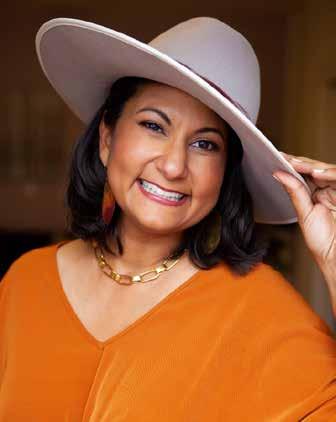
ATXWOMAN.COM | 13
Content
The world’s largest leadership community of chief executives, over 30,000 extraordinary global members, coming together to become better leaders and better people.
Sponsored
NEHA SAMPAT, CEO | CONTENTSTACK
The Piehole Project: Where Money Truly Meets the Mouth


The Piehole Project, a scholarship program for up-and-coming culinary students, opened their annual silent auction for Austin.

Nagavalli Sees You and Feels Your Pain

Austin-based Eastern Soul artist Nagavalli releases “I See You,” the first single from her upcoming album Numinosum.
Estani Frizzell: Finding Power in the Unique Estani Frizzell uses her musical accomplishments to champion a story of selfdetermination through children’s literature.
Editor’s Note: January cover story. Styled by Asma Parvez, with inspiration from Las Ofrendas, Nordstrom and Target
photo by Mark Guerra. “The Piehole Project: Where Money Truly Meets the Mouth” photo by Mica McCook. “Estani Frizzell: Finding Power in the Unique” photo courtesy of Estani Frizzell.

“Nagavalli Sees You and Feels Your Pain”

14 | AUSTIN WOMAN | FEBRUARY 2023
get enough of this issue? Check us out at atxwoman.com FOLLOW US @austinwoman FOLLOW
@
C onnect WITH US
Can’t
US
austinwoman LIKE US austinwoman
Don’t forget to visit and subscribe to the Austin Woman YouTube channel!
The Black Fund Awards Show
A night of fellowship to celebrate
and uplift local Black-led nonprofits.
On Feb. 27, The Black Fund promises “an epic night in support of Black Central Texans.” Presented by Austin-based financial institution Netspend, the awards show celebrates Black excellence, recognizing 16 Black-led nonprofits for their work in the community.
The Black Fund marks a historical moment for Austin. In the wake of the founding of several funds specific to various communities in the city, The Black Fund emerged in 2022 as a means to “unleash the power of Black-led organizations and uplift solutions to benefit the Black community in Central Texas.” Through education, power and wealth building, health and wellness and advocacy, The Black Fund covers every facet of what it takes to ensure success for Black-led nonprofits. In conjunction with proper funding, the Fund takes a wholistic approach to support for underrepresented (and certainly underfunded) nonprofits that need it the most. As a testament to its central mission, The Black Fund Awards show also marks the Fund’s first group of grants. It’s an opportunity for the community to come together and support organizations that have continued a legacy of greatness for Black Austinites.
Of course, what awards show would be complete without entertainment? Though keeping the specifics under embargo for the moment, the organization promises “live performances by Black creatives and a few surprises.” Certainly, this is a joyous occasion, a moment to come together in fellowship and celebration. Starting 2023 with positivity, The Black Fund
Awards show will set the tone for the Fund’s future and the future of Black nonprofits across the city.
The Black Fund Awards show takes place on Monday, Feb. 27 at the Paramount Theater at 6 p.m. Tickets are currently on sale. Join The Black Fund in their support of local organizations doing hands-on work in the community. “You don’t want to miss this special evening full of connection, community and culture!”

ATXWOMAN.COM | 15 C onnect WITH US
Photo courtesy of The Black Fund.
Who is a Black woman who inspires your equity work?
 CLAIRE HELENIAK, SOCIAL MEDIA SPECIALIST
CLAIRE HELENIAK, SOCIAL MEDIA SPECIALIST
Terry P. Mitchell, co-owner of Austin Woman magazine, is the Black woman who inspires me most in my equity work. I heard from her for the first time at the Austin Woman Thrive event in June 2022, and seeing her passion come alive as she spoke inspired me for the future of Austin Woman magazine and the future of a more inclusive world. Her work at the Black Leaders Collective along with the rest of the team, focusing on reforming the future, is truly impressive. Changing the future to be more inclusive and more equitable starts now!
JEN RAMOS PERKINS, DIRECTOR OF BUSINESS MANAGEMENT
There are so many Black women who have inspired my equity work over the years, but when our editor asked us the question this month, there was one person who came to mind immediately. Someone who champions people from ALL marginalized backgrounds: people from Black and Brown ethnic cultures, people in the LGBTQIA+ community, women and those who identify as women, young people who are still deciding how they identify. She sees people, sees their essence, and when that is not immediately clear she digs deeper, asks the right questions and listens with a keen ear and open heart to paint a beautiful picture of a person in a way that they often cannot see themselves. Someone who never takes enough credit for the impact she has in the Austin community—and in the lives around her. In the words of my kiddo: she is smart, nice, understanding, respectful, accepting and very cool. My staff pick this month is also a staff pick. Cy White is by far the Black woman who has most inspired my equity work and awareness tenfold in the last several years. Thank you, Cy, for all you do for Austin Woman magazine, the Austin community and for me and my family.

16 | AUSTIN WOMAN | FEBRUARY 2023 Staff PICKS
CY WHITE, MANAGING EDITOR
Two women come to mind, and both have equally inspired me. Pam Benson Owens and Meme Styles are two women who are intentional, outspoken and unafraid to say what needs to be said and do what needs to be done. Pam’s work with Six Square challenges the forces that would try to erase the city’s real history. Meme’s work to make tangible change in terms of equity for Black women and girls through her organization MEASURE Austin is driven by data and indisputable. Both women aren’t afraid to speak the truth, even when it’s unpopular or forces people to reconcile with some hard truths. While I have always made it my mission to uplift Black womxn and have been intentional about meeting and introducing Austin to these incredible women, I’ve become more determined and more fearless with the guidance, honesty and absolute ferocity of Pam and Meme.
SHURONDA ROBINSON, CEO

Tara Dudley, Ph.D., inspires me with her work to preserve the last known standing slave quarters in Austin at the Neill-Cochran House Museum. When you think about it, there is a reason that physical Black history does not exist in Austin and in most communities throughout the South. Tara’s work to preserve and tell the stories of the people who helped build Austin is a beautiful way to implement equity in our built and physical spaces. She teaches interior design history and architectural history courses at the University of Texas at Austin. Her scholarship examines the contributions of African American builders and architects to the American built environment, focusing on the antebellum and Reconstruction eras in the U.S. South.
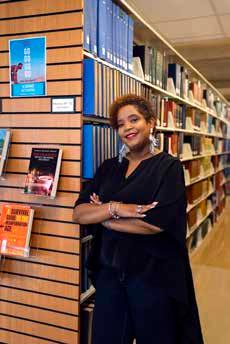

ATXWOMAN.COM | 17
Pam Benson Owens
Meme Styles
Dance to the Beat of Your Own Drum
BY SAMANTHA GREYSON
At the age of 19, Erika Nicole had her hands full raising her two young daughters. Fitness wasn’t a priority until she discovered Zumba, a workout class that revolves around Latin-inspired dance.
“I remember being like, ‘What’s this Zumba stuff?’” Nicole says. “I ended up just kind of giving it a try at my local class and just went from there. I fell in love with it because I’m half Puerto Rican, so it felt like I was just at home with my girls, dancing.”
More than 10 years later, Nicole now teaches Zumba classes of her own, where she mixes salsa, bachata, reggae and Top 40 music to create an eclectic, inclusive atmosphere for her students. Because Zumba changed Nicole’s life in a positive way, she strives to inspire others with Zumba and fitness in her program Move2Uplift.
“You feel comfortable in that space; you feel comfortable with the people that are there,” Nicole says. “You always feel comfortable with the instructor, and that has always been the theme of the music and the energy in general. This is our place, this is our people and we know why we’re here.”
Nicole also strives to promote inclusivity within her classes, which differs from some traditionally male-dominated fitness spaces.
“I always try to use the music and the moves and everything that we’re doing as an opportunity for people to take on these different characters,” Nicole says. “Whether it’s a funky little salsa and we tap into our feminine [side], or a little hip hop and we’re getting a little grimy and a little more masculine.”
With her expertise in dance, as well as her uplifting mindset, Nicole gives readers five tips to follow the beat of their own drum on and off the dance floor.

Hold yourself accountable.
On the dance floor, if you don’t continue to grow, you plateau. And if you don’t take constructive criticism, you can’t grow. The same applies to careers and relationships. Have the “ego courage” to ask for help so that others can hold you accountable.
Trust in your “secret sauce.”
Prioritize yourself. Believe in yourself and invest in improving yourself. Whether you’re an accountant and nobody sees those numbers like you do, or you are a great dancer and you are a pleasure to dance with and to watch, if you can learn to trust and believe in that every single day, you will lift yourself up in a way that nobody else can.
Consistency is key.
Practice doesn’t always make perfect, but it sure will make you a lot better. If you practice even the simplest steps, your dancing will improve, and if you set your mind to something, consistency is the only way to accomplish the task at hand. You could do it, whatever you set your mind to. You can do it, but you just have to have the discipline to get it done. Because if you don’t have the discipline, then you shouldn’t get to reap the reward of the end goal, whatever that is.
Don’t compare yourself to others.
Whether you are comparing yourself to a friend or family member who made all of the “right” decisions, or the person dancing next to you at the club, comparison is the antithesis of growth. We get trapped into feeling like we have to go by a certain rulebook. If we get caught up in comparing ourselves, we’ll almost turn into someone that we’re not. We won’t get to really live our true selves, our true authentic selves.
The timing is never right, but do it anyway.
Dancing may involve a lot of counts, and though you may keep track of the “one, two, three,” if you overanalyze these numbers, it takes the fun out of the dance itself. I think that also applies to life. I don’t always give myself the chance to get it wrong, to get it right, [to] just let it be. I think in general, if we can give ourselves more grace to explore what it even feels like to move, to do it anyways, we’ll get the timing right, we’ll get it wrong. Just go for it.
18 | AUSTIN WOMAN | FEBRUARY 2023 From the DESK OF
Local fitness instructor and Move2Uplift founder Erika Nicole fosters inclusivity while constantly promoting positivity.
Photo courtesy of Erika Nicole.


Nostalgia Through Color
Swathi Konduri finds community in Austin art markets and unlocks creativity through her craft.
 BY SAMANTHA GREYSON
BY SAMANTHA GREYSON
After taking art classes as a child and doodling in her notebooks throughout college, Austin artist Swathi Konduri picked drawing and painting back up during the pandemic, when she lived alone in a 400-square-foot apartment and desperately needed something to do.
“I took art lessons from when I was about 11 to 18 and I was bad during all of it—let’s be clear—and I really hated painting,” Konduri says. “But during the pandemic, I was so bored. I [thought], ‘Let me paint this stupid bookcase, I guess.’ That’s what got me back into painting. So it was just the boredom that made me retouch all of my old hobbies that I had neglected in college.”
Though she doesn’t describe herself as having natural artistic ability, through practice, Konduri’s artwork became a unique mixture of everyday occurrences with otherworldly vibrance, like that of a Dr. Suess book. Her style is fantastical yet realistic; it takes
the seemingly mundane and transforms it into a memory. A good memory, like driving in the car with the sunroof down and feeling its warmth.
During the pandemic, Konduri was able to create a strong internal validation system for her art, because no one was there to tell her it was good or bad. She knows her art is good, and that is what matters.
“Once I started showing my art externally, it’s great when people love my art, but it doesn’t affect me that much, and it doesn’t affect me that much if people don’t like my art. I created this because I wanted to, and I love it,” Konduri says.
Konduri first discovered Austin’s art market scene while working at a tech company pre-pandemic, making cold-calls to individuals who didn’t always give her the most positive feedback. She began selling her art in these markets a year later after falling in love with the community she found.
20 | AUSTIN WOMAN | FEBRUARY 2023 See HER WORK
“

ATXWOMAN.COM | 21
It’s nice to be in a community of people just like me, instead of being the only person like me.
—Swathi Konduri
Frank.. Again!
“I’m calling people who say, ‘Oh, unsubscribe,’ like I’m not a human,” Konduri says. “I didn’t really mind; I was getting paid to do it. But, yeah, rejection. As opposed to in the art space, where people are coming up to me because they like my work so much, and they’re treating me as a subject expert.”
The art markets were a stark shift from her corporate job, where she experienced sexism and was one of few people of color in her workspace. When she attended an art market, she was surrounded by strong, kind and talented women of color who worked to make her feel included.
“It’s nice to be in a community of people just like me, instead of being the only person like me,” Konduri says.

In July 2021, Konduri left her job to solely sell at the art markets. She has since continued to create art and has also tried her hand at web design, including one instance where she redesigned the website for Dee Dee, a local Thai food truck.
Konduri describes her art as surrealist. One of her favorite practices is using colored pencils to draw over a photograph she has taken and make small tweaks, such as enlarging the sun or enhancing the color.


Color becomes a character within Konduri’s paintings. It is at the forefront, and it makes her pieces feel like they exist in a dreamworld. Konduri creates art from her experiences, and hopes that these little glimpses of her own life will inspire others to think about their own. She describes her art as an extension of herself; it’s personal.
“I love evoking strong emotions in other people,” Konduri says. “Like nostalgia, I just want all of my pieces to connect to a personal memory for the viewer.”
Photos courtesy of Swathi Konduri.
A Lazy Sunday
Runny Sunset
Untitled Commission


ATXWOMAN.COM | 23
Dare to Imagine Another Storyline
Nigerian-American photographer and model Tumi Adeleye shreds perceived reality.
 BY CY WHITE
BY CY WHITE
Tumi Adeleye is a storyteller. She creates entire universes with her work. She’s a speaker, someone who uses her voice to bring others into unfamiliar worlds. She brings to mind the work of Jordan Peele: enigmatic yet uncanny. Images that distort the reality that exists in your mind.
“I have an idea, I fall asleep and dream about it and literally wake up in the morning and take notes of what I’ve dreamt about,” she says. “The way my brain works is I have all these thoughts and dots. They’re all connected. It’s like beautiful chaos that’s helping me function. That’s my flavor.”
It is within these dreamscapes where Adeleye confronts very real and lived societal preconceived notions of what it means to be a Black woman in the world. With her photography, she shreds perceptions of Blackness and Black womanness. For instance, with her Portrait of a Mad Black Woman series, she asks the viewers to really consider and reevaluate their biases of Black women. Wrapping herself in lace and soft fabrics, enveloping her face in flowers, she challenges the “mad Black woman” trope, instead forcing viewers to peel back their belief that Black women of passion should be minimized to “negative” emotions, stripped of their humanity and denied the grace to simply exist.
“A lot of times when I interact with Black men, men in general, I feel the way I’m handled by them, it’s a little harsh,” Adeleye admits. “Even when it comes to my facial expressions, there’s an innocence that I’m not granted from the world. And it sucks. It’s a red flag when a guy calls a girl crazy to another girl. Portrait of a Mad Black Woman is from being called that in the past. When I go out into the world, oftentimes I feel like I have to be really careful with the things I say. The men I allowed to love me, I had to treat them with more care just so I could be treated in a neutral manner. It’s only with other women that I feel understood and feel seen.
24 | AUSTIN WOMAN | FEBRUARY 2023 See HER WORK
Photos, direction and styling by Tumi Adeleye.
Portrait of a Mad Black Woman
Crowned
“That’s why I use the flowers,” she continues. “The vibrancy represents how I see my mind and how I see other Black women’s minds. Very vibrant, very colorful, and oftentimes when you come across something that’s so striking, people don’t have the patience to just try and understand or do something as simple as listen. I really desire to be held and treated with fragileness, even though I know I am strong. That’s an element about flowers that I really appreciate. They’re very strong. They light up any room, any part of nature. At the same time, when you care for flowers, you want to be really careful; you want to make sure you’re watering them. I talk to my plants. That’s a feeling that’s very rare for me to feel outside of anyone else but Black women.”
Adeleye has made it her mission to shake the foundations of the art world, using her storytelling like a sledgehammer to demolish the gentrification of the space. An admitted introvert, her work is a form of activism, a means to push the boundaries of what many non-Black folx have decided Blackness really means. Her art demystifies the Black experience. Leaning into surrealist Afrofuturism, Adeleye offers depictions of Blackness that embrace every facet of what that means.
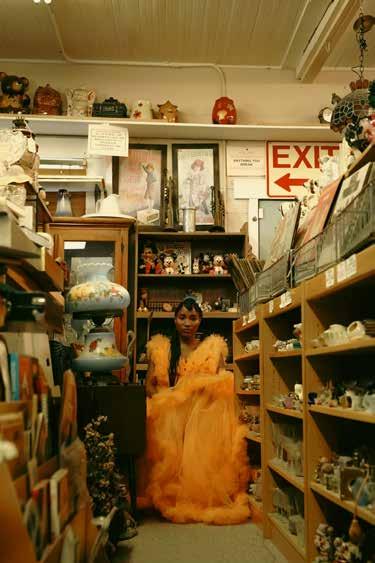
“My work centers around Black women, because they are my inspiration for everything. The fabrics that I grew up around, the sheets I use for sleeping, they were made from ankara,” she says. “It’s what people used for traditional clothing in Nigeria. I lived in an African household in Brooklyn and felt like I was living in Nigeria; then I moved to Nigeria, and that’s really what I was surrounded by. Africans are very, very, very proud. There’s a lot of pride in what they wear and even how they speak. The language, Yoruba, when I hear people speak it, it sounds like drums, especially when they’re very passionate about something. Growing up around that type of expression, it really influenced my choices.
“In my series Deeply Rooted, Afro Blues and even Pink Oil, those are all fabrics that I sourced from Lagos, Nigeria. I went to the markets and got all of those things, and I incorporated them in my photography because that’s what I know. That’s my reality. I’m really grateful for it. Even this simple sheet I did, Black Girl, Your Hair Is Alive, there’s a [feeling] of ‘I am here.’ Having pride in your presence on Earth and whatever you’re doing.”
Adeleye’s choice to use photography as her medium grew out of necessity, as so much of stumbling into one’s passion tends to do. Getting her start in UT’s advertising program, she was disillusioned by the prospect of applying to prestigious agencies and she switched gears. A photographer friend of hers introduced her to the world of modeling. She soon realized that so much of what she did on these

Sistahood
Eastside Risen Roses

Crowned
photoshoots was creative direction, yet she was only ever perceived as “the talent.”

“I would style myself, put the mood board together, choose the location and put the set together,” she reveals. “I realized that a lot of models are more creative than I thought they were. A lot of models style themselves, they have styling businesses, but after the work is complete, people just see them as a model. That’s because oftentimes they’re just getting credited as a model. I was like, ‘Okay, I’m just gonna shoot it myself, use a self timer and do it.’”
Adeleye embraces her artistic merits, is her own muse and brings her dreams to life. In her work 4cCherry, a whimsical yet undeniably surreal depiction of what she calls her “badass alter ego,” we get a glimpse of Tumi Adeleye as she sees herself: the storyteller, telling her own story because no one can do it for her.
“If I’m going to do something and I’m curious about it, why not just go all the way? Who’s going to tell me that what I’m doing right now is not correct? It’s art. There is no right or wrong. That freedom is what I seek whenever I paint or whenever I do photography. It’s a space where no one can tell me what to do.”

ATXWOMAN.COM | 27
“
If I’m going to do something and I’m curious about it, why not just go all the way? Who’s going to tell me that what I’m doing right now is not correct? It’s art.
—Tumi Adeleye
4cCherry
Aluoch
Closing the Wage Gap
Using tools to increase your salary.
BY JENNY HOFF
There is no one solution when it comes to closing the wage gap; societal norms, changes in business structures and regulations may all play a role in achieving that goal. While you may not be able to control these overarching issues, there are ways you can work toward increasing your own salary for greater equity in the workplace.

Negotiate, negotiate, negotiate. Multiple studies have shown women are less likely to ask for a raise than men. That doesn’t mean they don’t know their self-worth, but rather they believe that a manager or boss will recognize that worth and offer an increase in pay without being asked. Unfortunately, that’s not their job. A manager’s job is often to get the most amount of talent and productivity from someone for close to the lowest amount they’ll be willing to take for that work. Nearly every single position has a salary range, and your job is to make sure you’re not on the low end. While asking for an increase may feel intimidating, you can make it more comfortable by doing some research, learning the market rates for your position and utilizing online resources like glassdoor.com, where former and current employees anonymously post their salaries for positions like yours.
Network. Another way to find out what you should or could be making is by asking other people in your industry. Austin has a myriad of networking groups for almost any industry. Find one tailored to your profession or the job you want to work in and see if you can join. You not only find potential new job opportunities, but gain the wisdom from others who have been in your position. Some great networking groups you could join include Austin Women in Technology, Austin Professional Women, Austin Women’s Network, Austin Women Entrepreneurs and Women Who Code Austin. These groups are dedicated to offering mentoring opportunities, advice, resources and information to help you better succeed in your career.
Develop your skills. The rarer you can make your skillset, the higher price you can demand. Even if you’ve worked in an industry for many years, there are ancillary skills that could make you an even more valuable employee. From taking online courses at Coursera or another online platform to utilizing in-person programs in Austin, you can level up your skills within a few months.
Perhaps you’re in a position to help someone else further their career, either through a managerial position or mentorship. Or maybe you’re someone who knows how to ask for more money. Instead of keeping that information to yourself, find some female colleagues and show them the way. Join the groups and give insight into your salary so that, armed with more information, other women can ask for the same. If you’re a manager, commit to fair wages for your staff that are on par with the position and their experience.
If it’s hard for you to ask for a raise or network in order to increase your salary, think of it in broader terms. Other women who see you taking these steps will find the wherewithal to do it themselves; the person who takes your old position might get to start at a higher salary. You can better serve your community and family by earning what you’re worth.
28 | AUSTIN WOMAN | FEBRUARY 2023 On the MONEY


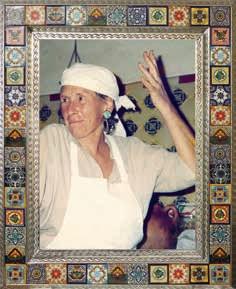
ATXWOMAN.COM | 29 Transparent, team-oriented renovations & builds 512-810-5400 www skellybuild com 2330 W. North Loop | Austin, Texas | 512.459.4121 | www.FondaSanMiguel.com IN HONOR OF DIANA KENNEDY’S 100TH BIRTHDAY Sunday, March 5th | 4-6:00 pm | Cocktail*+ Apps, $45/pp** DK liked being known as“The Mick Jagger of Mexican Cuisine”, Diana’s unparalleled research brought dishes from every region of Mexico to the world through her many cookbooks. UTSA will bring some of her collection for viewing. *Cash bar for additional beverages **Proceeds to help maintain her collection housed at UTSA. Your stu builds homes.
Austin
stable, and self-reliant
furniture,
cabinets,
paint,
South Austin 500 W Ben White Blvd Austin, TX 78704 Northwest Austin 13804 N US-183 Austin, TX 78750 San Marcos 2521 S Interstate 35 San Marcos, TX 78666
When you donate to your local
Habitat for Humanity ReStore, you help build strong,
communities and keep valuable, reusable materials out of the landfill. ReStores accept and sell new and used
appliances, doors, windows,
flooring,
plumbing, home décor, and more. Drop o your donation at one of three locations or schedule a pick-up online at austinhabitat.org/restore/donate.




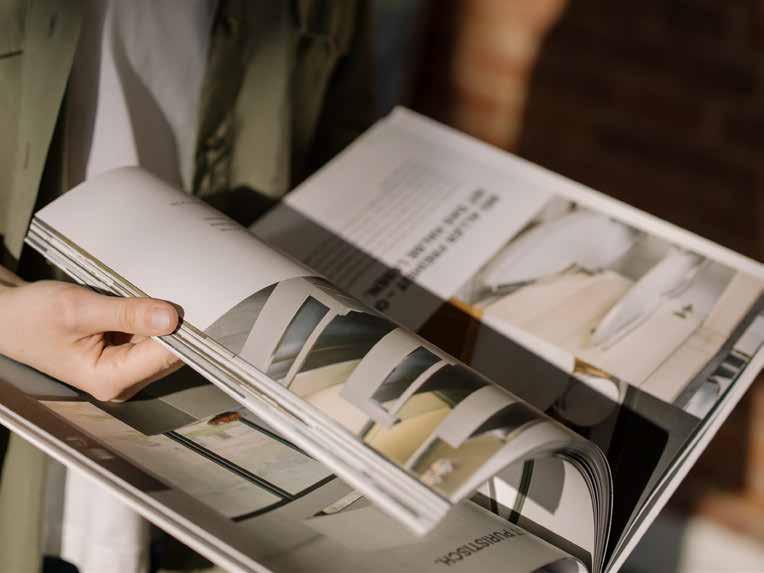

30 GAINING MOMENTUM BUILDING AWARENESS STRUCTURAL TRANSFORMATION SUSTAINABLE GROWTH A Minority & Women Owned Business www.theacaciacompany.com What to prioritize depends on where you’re at today. SCAN THE QR CODE AND TAKE THE 15 MIN ASSESSMENT TO GET YOUR FREE REPORT AND LEARN WHAT TO PRIORITIZE BASED ON YOUR ORGANIZATION'S CURRENT STAGE OF DEI DEVELOPMENT. Every organization needs a plan that supports growth in their current stage of integrating diversity, equity, and inclusion. Rachael Wyatt is a Certified Divorce Financial Analyst and has more than 25 years of experience in the wealth management industry. She has learned some hard lessons from her own personal experience & has helped many other women avoid pitfalls and find positive solutions. Develop a realistic picture of your financial situation and navigate the new chapter in life. Schedule with Rachael Contemplating divorce? Concerned about the financial impact? Know that you are not alone. W H A T T Y P E O F C O N T E N T W O U L D Y O U L I K E T O S E E ? R E A D E R S U R V E Y T A K E O U R O N L I N E R E A D E R S H I P S U R V E Y A N D Y O U C O U L D W I N A N H - E - B G I F T C A R D !


ATXWOMAN.COM | 31 GAME DAY SPECIALS CURRENT SPECIALS IN-STORE & ONLINE PLUS, GET COMPLIMENTARY GIFT WRAP AT ALL STORES! *Game Day Specials runs 2/6/2023-2/11/2023. Valentine ' s Weekend Sale runs 2/6/2023-2/14/2023. Valid on featured products. Sale items can be shopped in-store and online at twinliquors.com. Selection varies by store. Items and prices subject to change without notice. No further discount on Sale I tems, Final Few, or Closeouts. Some exclusions apply. PLEASE DRINK RESPONSIBLY. FEBRUARY 6-11 FEBRUARY 6-14 TWINLIQUORS.COM FOLLOW US ON SOCIAL TO STAY UPDATED SELECT SPIRITS SAVE ON VALENTINE'S SALE WINE & SPIRITS SAVE ON SELECT * *
Trailblazer with Her Mother’s Heart
For
BY KATHRYN FREEMAN PHOTOS BY ROMINA OLSON

32 | AUSTIN WOMAN | FEBRUARY 2023
decades, Joyce James has led the fight to end systemic racism in Texas.
STYLING BY ASMA PARVEZ (WITH ASSISTANCE FROM NOALANII KARAKASHIAN), WITH INSPIRATION FROM NORDSTROM AND ARBOR EYE CENTER.
HAIR BY VIKKI BUSH. MAKEUP BY MARISA WARREN ARTISTRY.
SHOT ON LOCATION AT HOLY CROSS CATHOLIC CHURCH.
You could say Joyce James was born to be a social worker. Her first example of what is now known as “kinship care” was in her own family. Her mother took in and raised her cousin, who was born prematurely, to help her aunt. “My mother was my first role model of a social worker,” James shares. “Even without a formal education, she was always helping others.” The values her mother instilled in her would carry her from Port Arthur, Texas, to the corridors of power in the Texas Capitol. With every step, she remembered the lessons her mother taught her, while fighting systemic racism and working to build communities of resilience in underserved populations.
Like many African American children with working parents, James spent her early years with her grandparents, who lived in Opelousas, Louisiana. When she was 8 years old, James and her brother moved to Port Arthur to live with her mom and stepfather. “Port Arthur was segregated. We lived like most Black families on the west side of the tracks, and while I did not know it at a young age, I eventually realized we lived there because there were designated areas where Black people could live.” James recounts having only Black teachers, segregated schools and hand-me-down books, uniforms and band instruments. She would eventually graduate from Lincoln High School and attend Lamar University. But those early experiences with racism and segregation in Port Arthur would stick with her.
“I have lived experience with white flight,” James says. “As Black people moved from the west side to the east side, white people began to move out of those areas, and the resources and investments in those neighborhoods left when white people did.” White flight refers to the large-scale migration of white people from urban areas into what became the suburbs that took place in the 1950s, ’60s and ’70s. James makes clear that she does not attribute these migration choices solely to individual racism, but to what she calls “structural racialization.”
According to the Kirwan Institute at Ohio State University, structural racialization is when systems and processes produce unequal outcomes along racial lines with or without the presence of racist intent. James describes how structural racialization impacted housing patterns in Port Arthur in the post-World War II housing boom. The federal underwriting of home loans favored white home buyers and treated African Americans as “adverse influences” on property values. Private loan companies adopted similar policies, and these policies ended up incentivizing racially homogenous neighborhoods.

ATXWOMAN.COM | 33

“
My mother was my first role model of a social worker. Even without a formal education, she was always helping others.
— Joyce James
“Realtors preyed on white fears and scared them with stories of what would happen if they lived near Black people,” James explains. In fact, the Federal Housing Authority actually refused to lend to white people who moved into Black neighborhoods. Resources tended to follow white families, and this divestment had both cosmetic and real consequences. “[Local governments] no longer invested in the communities where Black and Brown people lived; you did not see the same level of upkeep for the streets, the parks, the sidewalks, etc.” This is one example of structural racialization, but to James these systems are interlocking—housing patterns affect the local tax base, which affects the quality of public schools; segregated housing leads to environmental racism and the health effects that come from exposure from toxic waste. For James, understanding structural racialization plays a critical role in her work as a racial equity consultant.
Most of us see the dilapidation of urban communities and assume the renters and homeowners have made conscious choices to let things fall apart. But James encourages casual observers to look deeper, to inspect the groundwater. James’ groundwater analysis encourages her clients to look beyond just the surface, where it is easier to see differences, and examine the ways structural racialization and systemic injustice have created the world we see.
James is passionate about ending systemic racism, but she also has empathy for those still learning what that means and why it’s important. She did not always have language for what has become second nature to her these days. “I would love to say in my eight years as a caseworker that I raised [issues of systemic racism], but I didn’t,” she admits. “When I started, I was responsible for finding and monitoring placements for youth in residential treatment facilities, which are the most restrictive placements, and I became consciously aware that my caseload was primarily older African American teens. There was something about it that did not quite strike me as being normal.” She recounts visiting “her kids” and noticing that their needs for simple things like hair care products or lotion were going unmet.
For years, day after day, month after month, she would take kids from their home communities and drive them long distances across the state of Texas. As a young caseworker with Texas Child Protective Services in Port Arthur, James did not have a “clear analysis or understanding” and certainly did not “feel comfortable raising any
issues [with leadership].” Instead, she did what many African Americans do when trying to address injustice—she turned to her family and the Black church.
“I would go to my church and my family and ask them to help me to support the kids on my caseload. I would use the money to buy them hair care and skin care products, any small, little thing that I knew could make a difference for them.” James recounts the difference she would observe in her kids when they had products made for their hair texture and type. “The kids would look better, but there would also be fewer disciplinary referrals.”
Now after more than 30 years’ experience with child welfare systems, James realizes she was operating on the individual level. “I was dropping kids off in places I would have never wanted my own children to be in; [those experiences] gave me a better understanding of what it feels like to experience oppression inside of a system.” James emphasizes that it is not about “mean-spirited people” within the child welfare system. “We should all do and be accountable as individuals, but that’s not sufficient for the type of systemic change that needs to occur.”
It takes courage to confront long-held ideas and ways of doing things. James recognized that change must operate on both the individual and institutional levels. So, while the individual practices she instituted as a caseworker benefited the children on her caseload, they were not enough to overcome the systemic inequity built into the system. Even as she became a supervisor and began training the caseworkers underneath her to beg other organizations for resources for their kids and formed local African American adoption councils, this still was not enough. Her kids were being taken care of, but what about the others?
When James first became a program director, she began plotting how she could address the disparities in treatment she had witnessed in the system. “I’m seeing disparate treatment; I’m seeing race affect outcomes and how our children and their families are treated. While I did not attribute it to mean-spiritedness, people did not have a clue.
LOCATION: HOLY CROSS CATHOLIC CHURCH
Built by parishioners in what was formerly known as the Negro District in Austin in 1937, Holy Cross Church is the first Catholic Church to serve the needs of Austin’s African American community. In 1942, the church established Holy Family Catholic Church to serve African American Catholics in South Austin. Recognizing the lack of medical facilities to serve African Americans, the church established Holy Cross Hospital in 1940, the first hospital in Austin to allow Black physicians to practice. The church established Holy Cross Catholic School in 1941 and taught nursery through eighth grade until 1960. The church community significantly supports and guides educational, social and political issues affecting the city and state. Many of its parishioners served in elected office, including the Texas legislature’s first Black Speaker Pro Tempore, Barbara Jordan, and Austin’s first Black school board member, Wilhelmina Delco. 1610 E. 11th St. | holycrossaustin.org
ATXWOMAN.COM | 35
“
— Joyce James
They thought they were helping,” James shares as she reflects on what shifted for her. She began to realize her silence was doing harm too.
James was looking for an opening to talk with her supervisors, and the window into the conversation came through charts and graphs. She asked for some data disaggregated by race and ethnicity. “The data revealed everything that I had observed. For instance, Black children represented 29% of the child population in our largest county, but 80% of the kids in foster care were Black,” she recounts. James explains that no one chooses the low pay, large caseloads and stress of working in child welfare because they want to do harm. The data gave her an entry point to delve into the operations, policies, practices and training of social workers in Texas’ child welfare system to determine what needed to change to ensure better outcomes for African American children.
Working in a race-conscious and data-driven way allowed James to lay some common myths to rest—that the poor outcomes African American children were experiencing were the result of poverty and high rates of single motherhood. James chuckles. “People still believe today that it’s not about race or racism, but rather that it’s about single-parent households and poverty, and we dispelled that myth.” James and her team were able to demonstrate through the data that even when controlling for income and living in a single parent household, African American children still experienced the worst outcomes.
Here’s the thing about targeting those with the worst outcomes for improvement: The system improves for everyone. Caseworkers would seek the least restrictive placements for kids of every background, more judges would question the caseworkers about
placements, more parents would be given options for community services and more kids would be placed with relatives or close family friends rather than sent across the state. James is quick to recognize that the Texas foster care system is not perfect, and her tenure did not solve all the problems facing the agency. But in her first two years as the leader of CPS, “more children were leaving foster care than were coming in, we tripled our kinship placements and the number of families receiving services in their own home, but we also closed the gap in outcomes between children across ethnic and racial backgrounds.”
In 2004, James would be promoted to a regional supervisor, the first African American to lead Texas Child Protective Services, and then in 2009, to deputy commissioner of the Department of Family and Protective Services (DFPS). Ultimately, in 2011, James would see her decades of advocacy against systemic racism in the child welfare system rewarded when she was appointed the first director of the Center for the Elimination of Disproportionality and Disparities, a state-level agency charged with working across systems to address racial inequities. The agency was defunded in 2017, and James went into private consulting. But even knowing her work would be dismantled, she is quick to say, “I would do it all over again.” The models she created changed the lives of children and caseworkers in Texas and is still considered a national model. (Texas was one of the first states to require the child welfare system to address disproportionality, and to create a statewide agency to address systemic racism across state entities.)
36 | AUSTIN WOMAN | FEBRUARY 2023
More children were leaving foster care than were coming in; we tripled our kinship placements and the number of families receiving services in their own home, but we also closed the gap in outcomes between children across ethnic and racial backgrounds.

James sees parallels between the fight to defund the Center for Disproportionality and current debates about critical race theory. “I think that the pushback around critical race theory originates in fear and lack of understanding. Racism is not just about what white people do or have done; the real work is how systems have contributed to inequity and how we move away from just the individual lenses of who is right and who is wrong, to recognizing systems have certain relationships to people based on where they live and how they look.” James insists we must be willing to be educated, but we also must be willing to be vulnerable.
Vulnerability allows us all to be learners. In fact, many years ago, James held a workshop on the poor outcomes for African American kids in the Eastside of San Antonio. While it was easy to write off parents who did not attend the court-ordered parenting workshops as not caring about their kids, James actually made those in attendance consider that most of the workshops were on the other side of town and it took hours by bus to get to them. Needless to say, the participants left that meeting determined to make sure community services were in the communities that needed them.
The great African American writer Toni Morrison once said, “Two parents can’t raise a child any more than one. You need a whole community—everybody—to raise a child. And the little nuclear family is a paradigm that just doesn’t work. It doesn’t work for white people or for Black people. Why are we hanging onto it? I don’t know. It isolates people into little units. People need a larger unit.” James argues we need a large unit of those inside and outside our institutions, working in community and cross-racially to end systemic racism for the coming generations.

For James, the work has not been easy. She shares that the key to dealing with resistance is to expect resistance. “There is no quick fix; it requires a level of risktaking, but there is hope in that we know that with the right framework, we have the tools to reduce disparities for all people.” James also takes hope in the fact that two of her three daughters followed her into social work, and her son now works with her in her consulting business. Her chosen field cannot be all bad if her kids have followed in her footsteps. Despite the arduous nature of the work, James finds joy in her family, her husband John and in addition to her children, her eight grandchildren and seven great-grandchildren. She also takes joy in “seeing what can happen when people are willing to be courageous and engage in this work.” She consults with leaders across the country and recently returned from New York after working with one of the city mayors and his cabinet.
James also takes the long view and continues to immerse herself in the work. After over 30 years in child welfare and decades of leading equity, she is still building her capacity and teams to undo racism. She is still organizing local communities to fight systemic racism through co-founding Black Mamas ATX, which provides training to medical professionals and community-based organizations to address African American maternal mortality rates. She is still organizing church members to fight social injustice as the co-chair of the social justice ministry at Holy Cross Catholic Church in East Austin, which operated the first Black hospital and is the only predominantly Black Catholic church in Austin. Most importantly, she is still honoring the lessons she learned around the table with her mother. When her mother passed away a year ago, James and her family created Gladdie’s Angels in Port Arthur to keep her mother’s memory alive through financial grants to local organizations and churches. Like most mothers, Gladdie Stelly probably did not need a reason to be proud of her daughter, but she had every reason to be proud of raising a trailblazer with the commitment and courage to create a world free of racism where all children are free to thrive.
38 | AUSTIN WOMAN | FEBRUARY 2023

ATXWOMAN.COM | 39
Heavy Work
BY CY WHITE PHOTOS COURTESY OF SIX SQUARE
There are days when the rainbow isn’t enough. Pam Benson Owens, CEO of Six Square, has been there, carrying the weight of heavy rains only to find the rainbow faded of the color the deluge promised. But as she well knows, when you’re called to duty, you must stay with it until you’ve been told you’re through.
“This comes by way of a call from the elders,” she says. “I grew up in Austin. And so I know better than to go into a state of argument with the elders. I just go when and where, and it’s been like that ever since. As somebody who did a lot of my pivotal growing up on the East Side, it’s a calling. I will leave when I’m released to leave.”
Since 2013, this has been the mission of Six Square, a 501(c)(3) nonprofit whose call to action is to preserve the true history of this city. The idea for the organization arose during the city of Austin’s African American Quality of Life Initiative. A group of Austin’s Black residents called for the creation of a cultural and heritage district to protect and preserve the history of the city’s Black population. The ultimate goal was to create an economic engine to fuel the preservation of arts and culture and promulgate current and future guardians of the culture: artists, historians and preservationists. The organization represents the first cultural heritage district in the state of Texas. It has often been draining work, with nearly 10 years of pouring from a well to nourish the community around it.
Of course, this isn’t so new to the Black folx of Austin. Much has been given: music, food, education. Much, still, has been taken away. On March 22, 1928, the council of the City of Austin adopted a “Master Plan” that would push all of Austin’s Black population into a six-square-mile area of of the city “just east of East Avenue and south of the City Cemetery,” a means to ensure that Black and Hispanic Austinites were no longer a white problem.
Nearly 95 years later, racial segregation has a different look. No, it’s not overt (and certainly not legal). However, after almost a century, it still remains a difficult truth for this city to accept. There are two Austins: one that hangs tight to the notion that it is progressive and one that knows better.

“Living in a city that thinks it’s progressive is harder to me than [living in] a city that thinks it’s conservative,” Owens admits. “In a progressive city, or perceived progressive, there’s always the skewing of allyship. I don’t want more allyship; I want you to throw your entire body into standing in the gap and leveraging your privilege in ways that create paradigm shifts.”
Thus, the creation of Six Square. According to its mission, the organization was established “to preserve and celebrate the cultural legacy of the African American community that once thrived in Central East Austin through cultural arts, education, economic development and historic preservation.” Though known for its arts, Six Square is and always has been more than a foundation for artistic endeavors. Yes, we as a people have been blessed with an ability to tell our stories through art, through music, through writing. But,
40 | AUSTIN WOMAN | FEBRUARY 2023
For nearly a decade, Six Square has preserved the history and legacy of Austin’s Black population.
Photos courtesy of Six Square.
Pam Benson Owens CEO of Six Square
as has become something of a rallying cry for the community, Black people are not and never have been a monolith. Nor are the organizations, institutions and brother and sisterhoods that we build.

“People always say to me, ‘You’re Austin’s Black Cultural Arts District.’ I’m like, ‘I know you hear “arts,” but we are literally the preservers of culture.’ That comes from education, economic development, preservation. Nobody talks about that. We’re not doing art shows. Our body of work is preserving, removing obstacles, uplifting, creating paths for Black people. We go way beyond the canvas and way beyond the Six Square.”
With the need to preserve an entire population’s history and legacy, working with those in the city is paramount. This is where those not-so-ancient seeds of segregation crop up most prevalently in Owens’ experience. “It is daunting and exhausting,” she admits. “We’re in a city that thinks we are progressive because we do equality pretty well, but we don’t do equity well at all. I was in a meeting last year about arts funding with the city and some of my sister legacy organizations who are white led. They were like, ‘But we love everybody; we have a Black janitor.’ I’m sitting there, and I’m like, ‘This is my seventh teachable moment meeting today.’ I’m in that space a lot, and I just finally said, ‘I appreciate what you think you are doing, but equity looks a little different.’ This round of funding, you might not get funding, because for 30 years, you’ve gotten the top level of funding, and we’re just trying to get a little more; we’re not trying to take all your money. You’re on a call crying about you’re not going to be able to sustain yourself. Your donor
always say to me, ‘You’re Austin’s Black Cultural Arts District.’
— Pam Benson Owens
“
People
I’m like, ‘I know you hear “arts,” but we are literally the preservers of culture.’
base and my donor base look different. Your abilities to secure money and my abilities to secure money are different. I know that to be the case because I have raised money, both on the west side of 35 on golf courses, and on the east side. It’s still hard for a Black female leader.”
It’s unsurprising that this is a Black woman’s work. Activism, in all its many forms, has always been Black woman’s work. Owens is no exception to this rule and has emptied her well time and again to ensure that this organization continues to pour into its community. The community knows this and responds in kind.

Terry Mitchell, co-founder of the Black Leaders Collective, and new co-owner of Austin Woman magazine, fully embraces not only Six Square’s impact on her, but on the community she calls home. “Six Square has stood in the gap for grassroots community leaders in need of fiscal sponsorship, has sponsored numerous social impact events and initiatives, as well as created capacity-building opportunities for the creative community,” she says. “They are rigorously working to preserve and archive the history of Black Austin. Where the city has fallen short in lifting Black people of Austin, Six Square is filling the void.”
Even days when the rainbow should suffice, when it’s at its brightest, Six Square and its CEO have been overshadowed by ugliness. In 2021, Juneteenth was officially named a federally recognized holiday. It was another reason to celebrate resilience in a society that still has a hard time reconciling Black people’s existence. Unsurprisingly, the official decree gave many corporations carte blanche to commodify the day, attempting to pander to Black folx with novelty ice creams and decorations.
“This has been unpopular sometimes even with my board of directors, but we will not honor that with partnership,” Owens says. “I turned down organizations and donors who sat in the space of performative inclusion. It became not all money is good at money, and not all support is good support. Some days it was

42 | AUSTIN WOMAN | FEBRUARY 2023
Photo courtesy of Six Square.
“
I turned down organizations and donors who sat in the space of performative inclusion. It became not all money is good at money, and not all support is good support. Some days it was hard.
— Pam Benson Owens
Six Square-sponsored DAWA event U*N*I*T*Y at SXSW 2022
hard,” she admits with a chuckle. “Sometimes it physically hurt. Like I’m saying no; I’d be writing the email [thinking], ‘This is dumb, what am I doing?’ But we are going to be true to our identity around how we expect those entities and organizations to behave.”
Under Owens’ leadership, Six Square’s work now becomes fighting against structures that use pacification as a substitute for progress.
“We’ve had people that came to us and said, ‘We want to help you, we know your work is important. In order for us to do this event, we need this from you.’ It would be stuff like free labor, or creating representation on a panel so that they looked better. We absolutely could not. You have to lean into not just your personal identity, but your organizational identity, navigating the cost you can live with. I got really good at navigating the cost that I can live with, because I learned that the right partnerships will come. People who understand it will come. That’s hard in a capitalist environment.”
The 2020 celebration of Juneteenth became a particularly sharp point of ire for Six Square. While holding its annual celebration, intel came to them revealing that the Austin Police Department’s Austin Regional Intelligence Center had the event under surveillance, claiming concern that the celebration was in fact a gathering to organize those attending to start a riot.
“Here we are in meetings every day, trying to figure out how to lift programming virtually to support our people,” Owens recalls. “We’re doing mental health sessions, yoga. We are deploying entities to get people insulin and groceries and rental assistance. I have never felt that level of violation in my career. As I came off of that, I said, ‘Let us figure it out.’ We decided on a written response, which is what we did.
“They surveilled our yoga?” she says, the memory making the words sour in her mouth. “You want to know what tipped them, what created the issue? The title of our programming was ‘Black Minds Matter.’ That tipped them off that we were mobilizing to do some violent stuff. I’m out here [delivering] these artists groceries. We got funding, and we deployed about $101,000 the first year. One of our pillars is economic development. One of our pillars is education. You can’t paint if you’re hungry. You can’t make music if you don’t know where your insulin is coming from. You can’t do your craft if you don’t have insurance. We are on a mission, and the mission right now is to make sure that Black artists, creators and entrepreneurs don’t leave the city.”

Echoes of COINTELPRO, a dark shadow of insecurity and unsafety, cast over an event meant to uplift and unite our community. “I’m not sure if people really realize the complexity of leading while Black,” Owens laments. “The weight of that situation really did a job on me. There are pockets of the city that I still don’t feel particularly safe in. But that situation made me feel like they walk among us, unsafe. Like you could actually be fronting as an ally and not be that.”
Yet despite these hardships, despite the toils of preserving the true history of Black folx in Austin, Six Square stands tall and has since its creation in 2013. It has seen the leadership of incredible, powerful Black women, including Austin Woman’s CEO Shuronda Robinson. Owens herself has been involved with Six Square for eight of those years in one capacity or another. In 2022, she took on the role of CEO, a fitting title for someone who’s done so much to order her steps in this organization’s vision. Her work has had a ripple effect across Austin.
ATXWOMAN.COM | 43
“The reconnection that has been the most bountiful and heartfelt relationship with Six Square was under Pamela Benson Owens,” says Qi Dada, one half of revolutionary hip-hop duo Riders Against the Storm. “So many endeavors artistically have been able to make an impact in the community that broadened the palate of what Black art is in Austin. [Six Square] has heightened possibilities and provided a comfort as an artist to know that there is a space that is a backbone and not a deterrent.”
There has been great triumph even in the wake of some horrible racism. During the height of the COVID-19 pandemic, Owens managed to keep her employees fed, as well as families all over Austin. She has taken Six Square to the next level and will continue to do so in 2023. Those who have been directly impacted by Six Square know firsthand the need for this organization, what it means to the community and how it will continue to support the legacy of Austin’s Black and Brown population.
“I anticipate Six Square to grow its community outreach,” Mitchell says. “I’m sure they will help to lift even more creatives. I anticipate that Six Square will continue to find creative and interactive ways to preserve and archive Black history in Austin.”
Qi Dada shares this view of Six Square’s future. “My hope in moving forward is that that relationship continues and expands into spaces we haven’t reached yet, organizations we haven’t touched yet,” she says. “That our commitment to art is always multifold, that it’s not just about supporting the artist but primarily that the artist can also attach themselves to a need in the community.”

44 | AUSTIN WOMAN | FEBRUARY 2023
“
I anticipate Six Square to grow its community outreach. I’m sure they will help to lift even more creatives. I anticipate that Six Square will continue to find creative and interactive ways to preserve and archive Black history in Austin.
— Terry P. Mitchell
No, the ancestors are not done with Pamela Benson Owens. And Six Square isn’t done keeping the legacy of Black folx alive, well and thriving in Austin.
“[Our future] looks like a keen focus on going after systems that erode and omit our people. Uplifting, supporting and removing obstacles for artists, creatives and entrepreneurs in a way that opens up access to all opportunities for them to work and be and do. Your art should be at Tesla; your art should be at Dell. Why is your art not in the airport? For everybody that wants to start a business, [create] paths that support that. Finally, continuing to cultivate cross-cultural collaborations in a way that when we go into spaces, like Paramount, and Long Center, and Mexic-Arte and The Contemporary, that we are not guests. We are also looking at how to build Six Square’s infrastructure, even down to an endowment, so that it lives beyond this. Six Square is not Pam Owens, and it’s not the current people. [We’re going to work out] how to build it in a way that sustains in perpetuity.”



46 | AUSTIN WOMAN | FEEBRUARY 2023 WANT TO BE A Receive the recognition YOU deserve as one of Austin’s success stories. Each month, Austin Woman features ATX Women to Watch in a beautiful special promotional section. Don’t miss out on this exclusive opportunity! Email sales@awmediainc.com today. Included in the package is: • Full-page profile in the magazine • Custom photo session in your choice of location (and you keep the photo for personal use!) • Feature email blasts and social-media posts • Invitation to a private networking group • Invitation to exclusive ATX Woman to Watch connection events Show our readers the WOMAN behind the BRAND WOMAN WATCH? TO
LLC,
FINANCIAL PLANNING L et’s celebrate! Glenda Molina radiates joy every single day through the work she does empowering her community. She values connection and kindness, the pillars of her professionalism. Helping others accomplish their goals motivates her, especially ambitious female leaders who seek to achieve financial freedom to make an impact on the world. As a Certified Financial Planner™ at Silicon Hills Wealth Management, she guides individuals and families through fun planning sessions, collaborating with their trusted network of professionals to align their wealth with their vision and goals. In her director of financial planning role, Molina navigates life stages with you, from retirement savings to spending strategies, or maximizing new wealth from a windfall such as inheritance or equity compensation, building a longstanding trusted relationship. With a wealth of knowledge in philanthropy, she loves guiding clients along their personal giving journey, and her contagious enthusiasm ensures everyone’s experience is fulfilling and exciting. siliconhillswealth.com/our-firm/glenda-molina ATX WOMAN to WATCH 34 | SPECIAL PROMOTION | ATXWOMAN.COM
GLENDA
MOLINA
SILICON HILLS WEALTH MANAGEMENT,
DIRECTOR OF
ATXWOMAN.COM | 47
Seven Years & Counting
BY BROWN GIRL IN RECOVERY

Seven years ago, newly sober but still thinking and wanting alcohol pretty badly—to the point where I would unconsciously salivate for it—I was introduced to the phrase “anchor in the now” via an intricately designed tattoo on a stranger’s arm. It floored me because it made so. much. sense. I approached her and we talked about her tattoo. It ended up being a deep philosophical conversation on life.
That phrase still floats to the front of my brain. Sometimes I reflect on “anchor in the now,” and I think of how far I’ve come. Sometimes I reflect on it because I am focusing on being in the present and stopping my monkey mind (a phrase I learned from Dan Harris in his book 10% Happier) from doing what it does best: running around all over the place, flinging poo and making a mess.
Today, as a 30-something Brown woman from an immigrant family now with a loving family of her own, people probably think I have it all together and always have. I sound pretty decent on paper, and I outwardly present myself well enough. I have a master’s degree, I volunteer, my professional work allows me to give back to my community in a meaningful way and I practice yoga and meditation on the regular. No way could I be an alcoholic. No way do I still continuously listen to Alcoholics Anonymous meetings. No way do I struggle to keep anxiety and depression at bay.
I think it is important to share my journey to sobriety and where I stand with it now because it might help a fellow brown woman like me feel less alone and realize that they are not inherently bad.
Also, it allows some of the shame and embarrassment I still feel about being an alcoholic to dissipate a little bit. So here we go.
The new me began seven years ago. That is when I became sober. I gave up alcohol, not because I wanted to, but because I was hospitalized twice, put in protective custody and basically needed to let it go in order to survive.
I began drinking when I started college. I prided myself on not drinking until then. Even though the legal age to drink is 21, we all know drinking can begin way before then. My purpose in drinking was to party hard and have a good time, and boy did I accomplish my purpose. I maintained a near perfect 4.0 GPA, was heavily involved in a sorority where I met some amazing women and consistently volunteered. I made some lifelong friends. I loved college. It was everything I dreamed of, and I was truly happy. It is one of the few times I can vividly recall this true happiness for an extended amount of time.
I also drank heavily when I was out with friends, but everyone was doing it. So that made it okay, right? If they could handle it, I could too. Plus, I did not let it interfere with my goal of going to law school. I was not an alcoholic at this point.
So, when did I become an alcoholic? It is not quite so linear. It is messy and embarrassing. But it is my reality. In writing all of this and sharing more in the months to come, I hope to give other Brown women a space to reflect, perhaps nod along and hopefully realize life is going to eventually be okay.
48 | AUSTIN WOMAN | FEBRUARY 2023
Photo courtesy of Brown Girl in Recovery.
Brown Girl in Recovery recounts her journey to sobriety by starting at the beginning.
Brown Girl IN RECOVERY

FEB. 25 to MARCH 11 The VORTEX



The VORTEX presents i see you, you’re seen, a solo performance that tracks Oktavea LaToi’s personal journey toward communal healing, self-love and healthy relationships in a world that is killing us with racial violence, fetishism, climate crisis, rage and a global pandemic. A fusion of art, poetry, music and movement, this new work explores the interlocking oppressions of Black women, while illuminating their lineage. Oktavea LaToi brings on the Revolution, inviting us to bask in beauty and acknowledge our sacredness. https://qrco.de/iseeyou2023
MedievalXModern DEC. 10, 2022 to JULY 9, 2023 The Blanton




Medieval X Modern presents the work of modern artists from Europe and the Americas who created prints, drawings, paintings, illustrated books, sculptures and decorative objects informed by the spectacular craftsmanship and compelling historical figures of the Middle Ages. Drawing primarily from the Blanton’s permanent collection, Medieval X Modern offers a wide array of artistic responses to the European Middle Ages, including one of the museum’s most iconic works—Ellsworth Kelly’s Austin

Arts IN REVIEW
iseeyou,you’reseen
It’s time to get out and enjoy everything that Austin has to offer, including an amazing arts scene. Austin Woman wants to help you showcase the great shows and performances that you’ve been planning. Fill the house! Please reach out to us at sales@awmediainc.com or fill out the form from the QR code! FEEBRUARY 2023






















We offer standard and detailed cleaning services for your residential and commercial space. Call for a free estimate. 36 Years Serving Austin BBB Accredited Business Locally Owned Fully Insured Mention this ad for 20% off a detailed cleaning. START FRESH IN 2023! AmesCleaningAustin.com 512.331.9694 | 12308 Hwy 620, Austin Effective-Exec.com What’s Your Business Personality Profile? • Meet and exceed goals • Reduce client and employee attrition • Build a cohesive culture FREE ONLINE TEST Get your “business personality” profile at Effective-Exec.com Complimentaty team assesment. Our free online business personality profile provides the data to identify top performers and struggling team members. Receive concise instruction to improve engagement and performance based on their inherent business personality traits. Ready to move the needle at your company? OFFICIAL EVENT PRODUCTION COMPANY OF AWMEDIA INC. SciKidz Club Club SciKidz SciKidz Where ience & chnology nnect! Sc Te Co austin@clubscikidz.com 229-444-3231 Complete registration online! Austin.ClubSciKidz.com • Minecraft • Pokemon Professors • American Doll • Entomology • Wizarding World • Marvel Movie Maker • Roblox • Special F/X Zombie • Grossology • Nintendo Labo • Coding • Engineering Including: 70+ STEM and STEAM Camps to Choose From! Science and Fun! Austin’s BEST SUMMER CAMPS
A Community of Women
Roku Inc. Vice President, Global People Business Partner Ericka Tate embraces the support she’s found in other women.
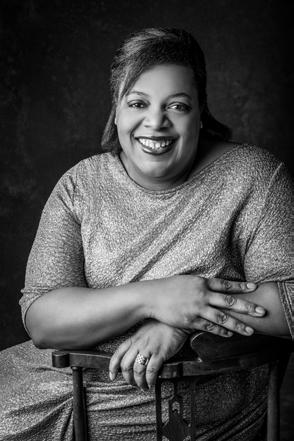 BY ERICKA TATE
BY ERICKA TATE
W
hen I think about being a part of Austin’s community, gratitude is first on my mind. I first joined this community because I had a dream of something different for myself and my family. Despite the great life I was living in San Jose, California, I held a different value system than the community I was living in. I craved and wanted more. I was stuck in the race of only working for the best companies, climbing the ladder of success quickly, remaining focused on getting more and more of the stuff that held little value to me; while deep inside, I knew that my values and my heart were not aligned to the community that I was in. I knew I had to make a change and lean into what was in my heart.
I wanted more family time, and I was not finding a job that matched my needs. I wanted to be present in my life and have my job as something I did, not who I was. And I wanted to stop making sacrifices for things that ultimately did not matter. I knew I needed to find a community more aligned with who I was. The journey I went on to make this change was not an easy one.
To most I had it “all.”
I worked for a great tech company, owned my own home in one of the most expensive places to live and had the world’s most adorable 9-year-old son. As a single woman, these were accomplishments like no other. Yet I dared to dream of a life that included my son walking to public school with his friends, like I did as a child. I dreamed of leaving work at 4 p.m. without judgment to make his basketball games and school performances. I dreamed of knowing my neighbors well and inviting them over for barbecues and birthday parties. I dreamed of moving to a place I could afford to live in and still travel and enjoy life while planning and saving for my retirement.
Thankfully, I found that in Austin. I found so many great and unexpected things that helped my dreams become my reality. I found people were generally interested in getting to know me and offering up advice on the best places to eat, shop and even a list of their favorite doctors. The community welcomed me, and I knew I had made the right decision. The city has a vibrant vibe, and I enjoyed exploring all that it had to offer. I knew that my values were more aligned with the Austin lifestyle, and this was the place for me to raise my son.
However, it didn’t take that long before I was met with some of the more unpleasant sides of this community. California, especially the Bay Area, is an extremely inclusive environment, but I learned that not all of Austin is the same. My son was confronted by a kid at school who made a racial threat against him, and I was faced with coworkers who simply didn’t like me for no apparent reason. I know with the good comes the bad, but I wasn’t quite prepared for all of it.
Thankfully, I reached out to those who originally welcomed me. I found such reinforcement and solidarity in the women of Austin. They had my back. They showed up for me. They supported me, not only with their words, but with their shared experiences. Since then, my community has grown with people from all over, but there is no loyalty, there is no helpfulness and no encouragement like what you receive from a woman from Austin. In my experience, they truly want to help and be there for their fellow woman. I’m not sure what I would do without them, and thankfully I don’t have to find out. Being an Austin woman means so much, and I’m so grateful to count myself as a part of this incredible community.
52 | AUSTIN WOMAN | FEBRUARY 2023 I am AUSTIN WOMAN
Photo by Jennifer Lindberg Studio.

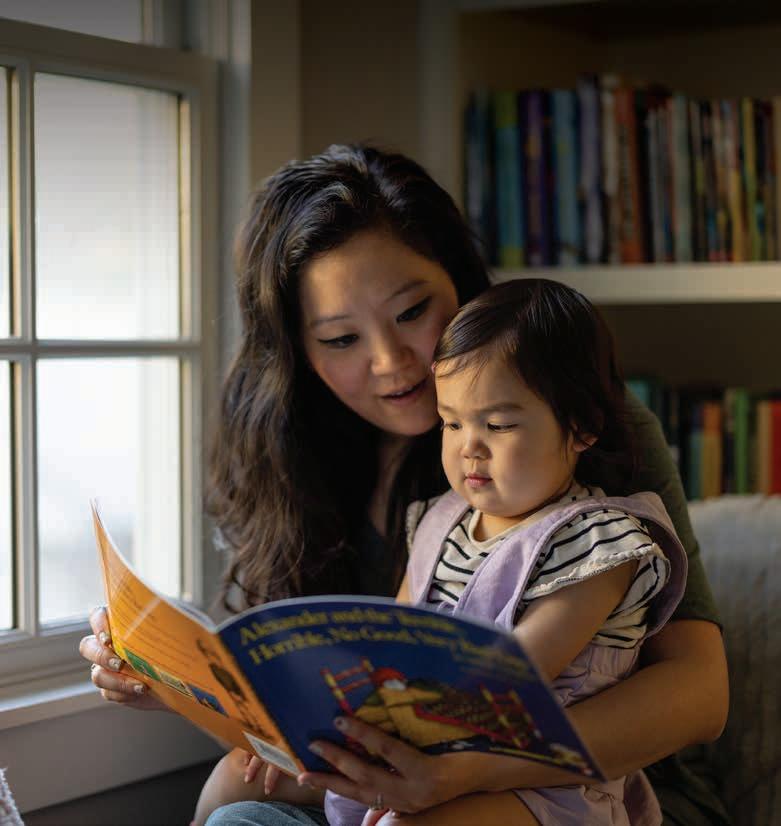

Learn more by watching “Hope Lives Here” at stdavids.com. The Best Is Here. Austin 2236 West Braker Lane 512.451.1233 San Antonio 18603 Blanco Road 210.545.4366 furniture & accessories for your modern lifestyle since











 BY CY WHITE
BY CY WHITE







































 CLAIRE HELENIAK, SOCIAL MEDIA SPECIALIST
CLAIRE HELENIAK, SOCIAL MEDIA SPECIALIST







 BY SAMANTHA GREYSON
BY SAMANTHA GREYSON






 BY CY WHITE
BY CY WHITE




























































 BY ERICKA TATE
BY ERICKA TATE


